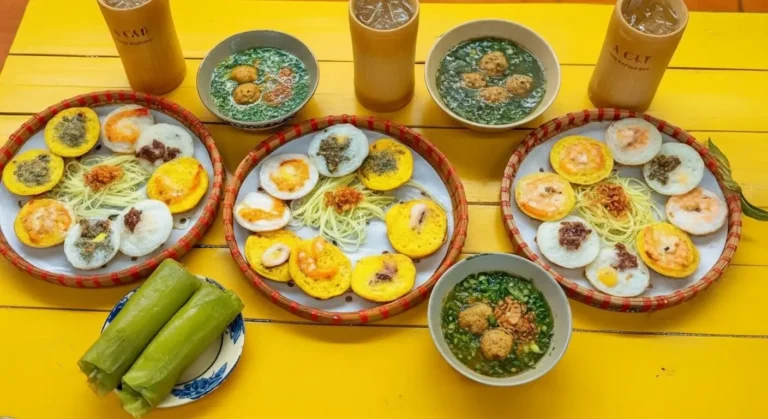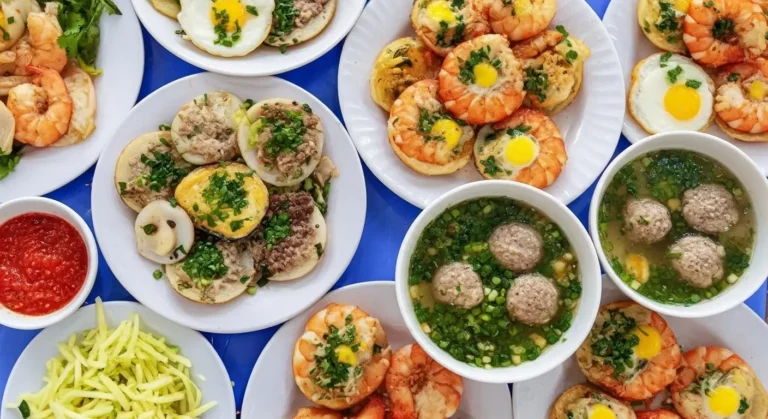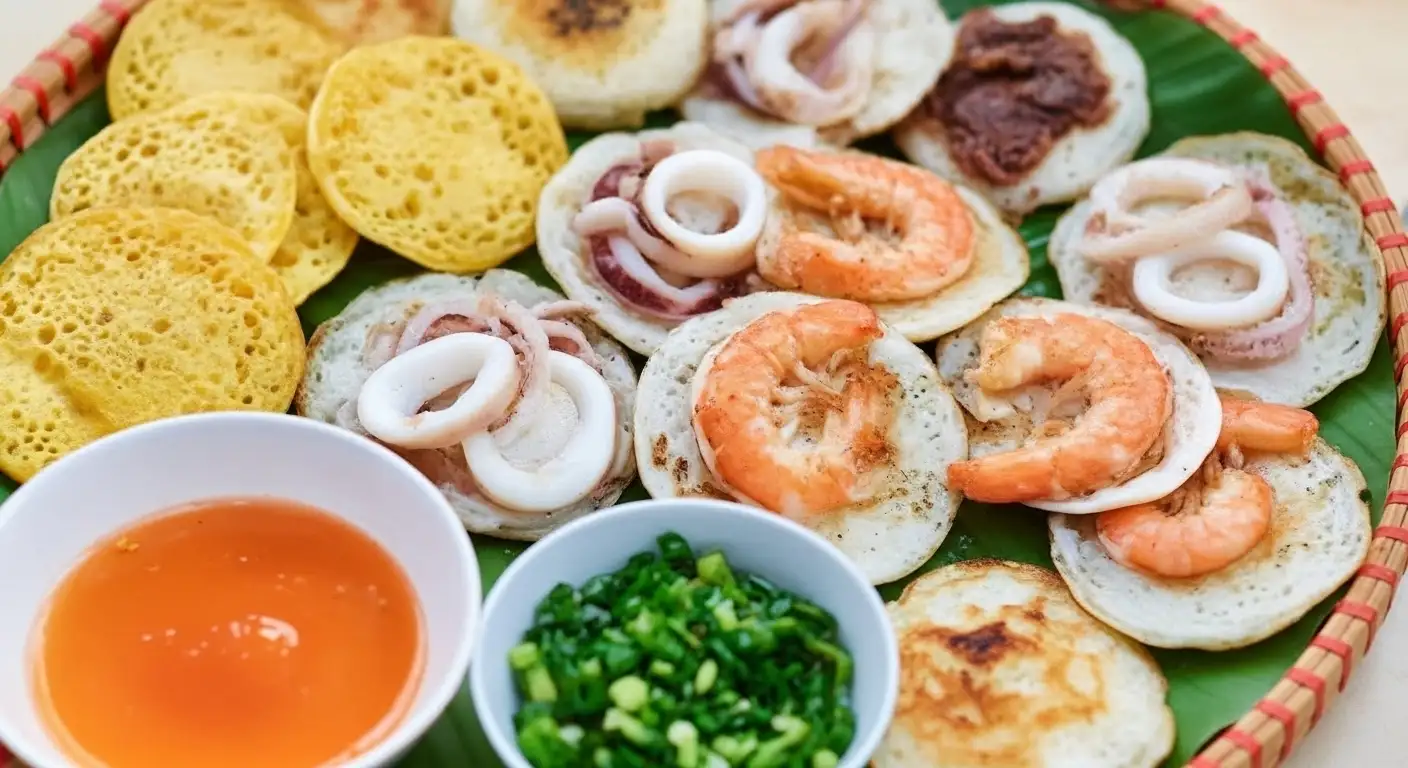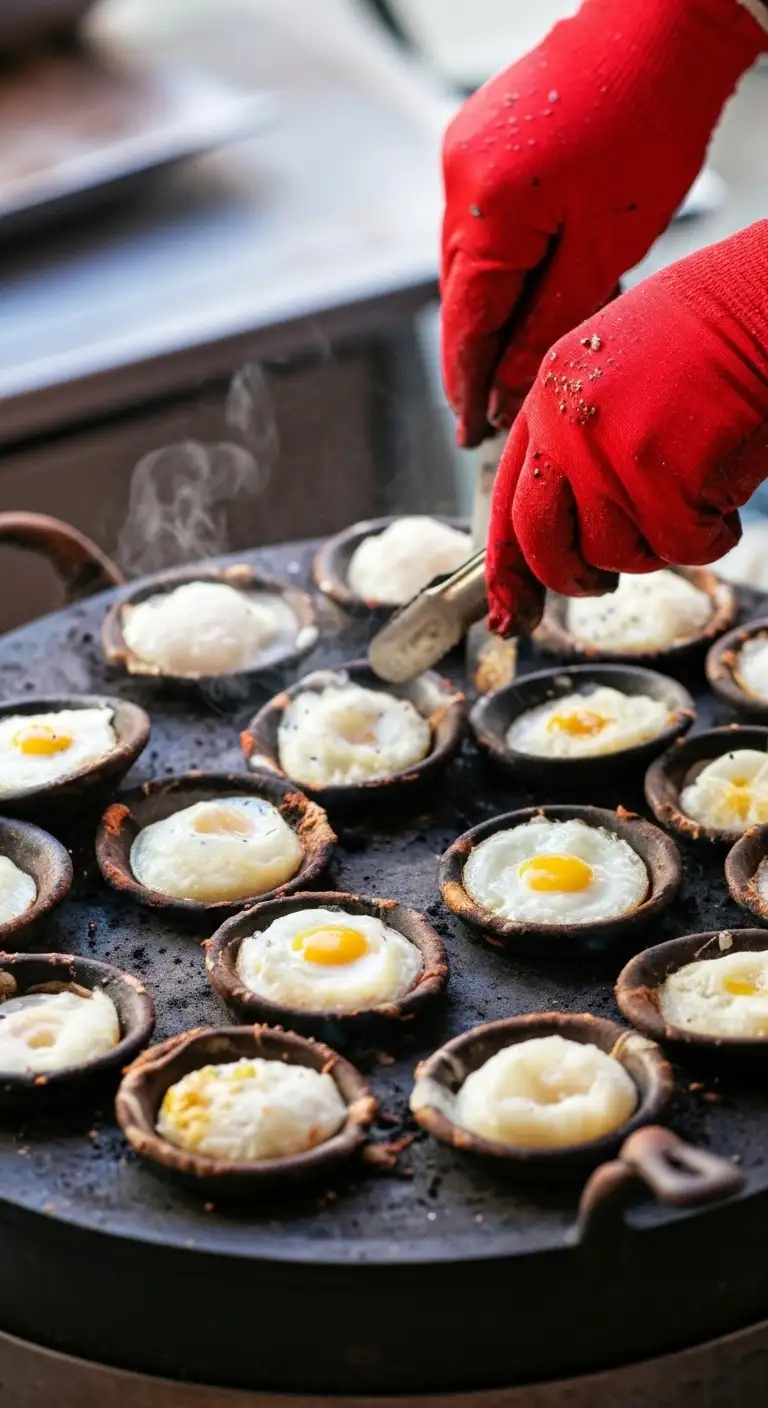Bánh Căn (pronounced bahn cun) is a delectable savory mini-pancake most commonly found along Vietnam’s South-Central coast. While it looks visually similar to its Southern counterpart, Bánh Khọt, Bánh Căn is distinguished by its unique preparation method and softer texture. It is a comforting, rustic dish cherished as a popular afternoon snack.
The Basics of Bánh Căn
What is it?
A savory miniature rice cake, often called a Vietnamese mini-pancake. The name Bánh Căn has no clear English translation but refers to the small, baked nature of the cake.
The Key Difference (Baked vs. Fried):
Unlike Bánh Khọt (which is fried in a generous amount of oil and is golden-yellow with turmeric), Bánh Căn is essentially baked or steamed in its mold using minimal oil. This results in a pancake that is white, soft, fluffy, and tender on the inside, with only a slightly crispy base.
The Cooking Technique:
Bánh Căn is traditionally cooked in a specialized terracotta or clay mold with multiple round indentations, which is heated over a charcoal brazier. This unique mold and heat source contribute to its soft, signature texture.
The Batter:
The batter is typically a simple mixture of rice flour and water, sometimes with a touch of coconut milk, but it notably does not contain turmeric, leaving the pancakes white.
Serving Style:
Due to their small size, Bánh Căn is almost always served in pairs, placed together like a small clamshell.

Types and Variations of Bánh Căn
The variations in Bánh Căn are primarily defined by the topping added to the batter during the cooking process.
| Type Name | Key Topping | Associated Region/Style |
|---|---|---|
| Bánh Căn Trứng Cút | Quail Egg (Trứng Cút) | Most Common throughout the Central Coast (Nha Trang, Ninh Thuận). A small quail egg is cracked directly onto the batter in the mold. |
| Bánh Căn Tôm | Shrimp (Tôm) | Also very common in coastal towns. A whole, peeled shrimp is placed on top of the batter before covering. |
| Bánh Căn Mực | Squid (Mực) | Popular in coastal areas like Phan Rang and Quy Nhơn, featuring small pieces of squid. |
| Bánh Căn Đa Lạt | Special Dipping Sauce | Đà Lạt (Central Highlands). This version is often served with a very thick, savory, warm dipping sauce made with pork meatballs (xíu mại) and pork skin (da heo), rather than the traditional fish sauce. |
| Bánh Căn Thịt Bò | Beef (Thịt Bò) | Less common, but variations exist with marinated ground or minced beef added to the center. |
How to Eat Bánh Căn
Eating Bánh Căn is an interactive, savory, and fresh culinary ritual that involves three main components: the cakes, the fresh greens, and the sauce.
Prepare the Wrap (Optional): While you can eat the cakes directly with chopsticks, the traditional and most refreshing way is to wrap them. Take a piece of lettuce or a leaf of mustard green.
Add Components: Place the pair of Bánh Căn (separated or still attached) onto the leaf. Add a small amount of fresh herbs (like mint, perilla, or Vietnamese coriander) and a sprinkle of shredded green mango or pickled vegetables (carrots/daikon).
Roll and Dip: Roll the leaf tightly around the pancakes and fillings. The whole package is then dipped generously into the prepared sauce.
The Sauce is Key: The dipping sauce is critical. It is most often a light, tangy sweet and sour fish sauce (nước chấm), but the version with pork meatball sauce (xíu mại) in Đà Lạt is equally famous. The freshness of the raw vegetables and the tang of the sauce balance the savory richness of the hot pancake.

Regional Differences
Bánh Căn is overwhelmingly a regional specialty of Central and South Central Vietnam. It is largely absent in the North and is often confused with its crispy, Southern cousin, Bánh Khọt.
| Region | Style and Preparation | Key Difference & Sauce |
|---|---|---|
| Northern Vietnam | Non-existent. | The traditional, non-crispy, mini-pancake style is not part of the core Northern street food culture. |
| Central Vietnam (South Central Coast: Nha Trang, Phan Rang, Quy Nhơn) | The Origin/Classic Style. Cooked in a clay mold with minimal oil, yielding a white, soft, baked texture. The pancakes are almost always served in attached pairs. | Main Sauce: Simple, light, sweet, and sour Nước Chấm (fish sauce). Sometimes served with thin fish soup/broth. |
| Central Highlands (Đà Lạt) | The Meatball Special. The cooking method remains the same (baked/soft), but the accompanying sauce is the defining feature. | Main Sauce: Thick, warm, savory pork meatball and pork rind sauce (xíu mại), which the pancakes are dunked into. |
| Southern Vietnam (Ho Chi Minh City/Mekong Delta) | Replaced by Bánh Khọt. While vendors sell Bánh Căn in the South, the region's true mini-pancake specialty is the yellow, crunchy, and oil-fried Bánh Khọt, which is often what Bánh Căn is called or substituted with. | If found, it will be the white, soft Central style, but the Southern dipping sauce will typically be sweeter. |




